Articles
RA Collection

RA Exhibitions
12 months ago
The meteoric rise of Angelica Kauffman RA
Historian Jenny Uglow tells the story of how Angelica Kauffman became a founding Member of the RA and one of the most revered artists in Georgian Britain.

Our Collection
1 year ago
Untold Stories
Recent research reveals how the Royal Academy’s founding artists worked amidst Britain’s imperial expansion in the 18th century, the transatlantic slave trade, and a growing abolitionist movement.

Inside the Academy
> 1 year ago
Quiz: guess the artist from their Diploma Work
When an artist is elected to the Royal Academy, it’s a tradition that they give one of their works to our Collection. Known as Diploma Works, we’ve gladly received quite a few in our 254-year history. So, can you name the artist behind these?

Our Collection
> 2 years ago
RA Collections Decolonial Research Project
Over the past year, our team has been investigating the links between the RA and its colonial past. In our first post on this subject, we offer an update on this work, and capture how we’re documenting associations between 18th- and 19th-century Royal Academicians and colonial activities

RA Exhibitions
3 years ago
Late Constable Tour with Curator Anne Lyles
Explore the exhibition of late works by one of Britain’s best-loved artists.

RA Exhibitions
3 years ago
John Constable’s last decade
Constable didn’t know he was entering his ‘late’ period, but in the last ten years of his life he sought truth in nature, and created landscapes infused with timeless imagination.

Our Collection
> 3 years ago
A slow look: Yinka Shonibare’s ‘Cheeky Little Astronomer’
Take ten minutes to meditate as we guide you through a slow, mindful look at Yinka Shonibare RA’s sculpture.

Our Collection
> 3 years ago
A slow look: Oriana Reinagle’s ‘Study of trees’
Enjoy five blissful minutes of mindfulness and art with this guided meditation.

Our Collection
< 4 years ago
A slow look: John Aldridge’s ‘Artichokes and Cathay Quinces’
Take ten minutes to meditate as we mindfully guide you through John Aldrige’s still life painting ‘Artichokes and Cathay Quinces’.

Our Collection
< 4 years ago
A slow look: Rodney Burn’s ‘Bracklesham Sands’
Spend 10 mindful minutes on a guided meditation through the details of Rodney Burn RA’s ‘Bracklesham Sands’.
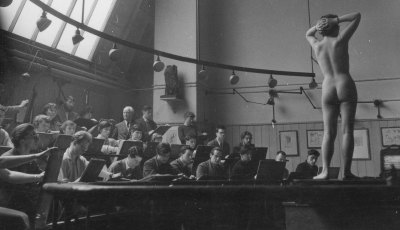
Our Collection
< 4 years ago
Naked truth: the story of female life models at the RA
What does a 230-year-old household bill tell us about life modelling in the 18th-century? Here, we explore the historical role of the female nude life model at the RA.

RA Exhibitions
< 4 years ago
Mary Moser and Angelica Kauffman: the RA’s founding women
Angelica Kauffman and Mary Moser were the only two female founders of the Royal Academy. Here, we take a closer look at their careers and the challenges they faced within the RA.

Our Collection
< 4 years ago
Victorian women and the fight for arts training
19th-century women faced an uphill struggle to get equal access to training at the Royal Academy Schools. Here, we delve into the RA Archive to learn more about women’s fight for equality.

Our Collection
< 4 years ago
In 60 seconds: Waterhouse’s ‘A Mermaid’
Spend 60 seconds exploring the dark mythology behind John William Waterhouse RA’s ‘A Mermaid’.
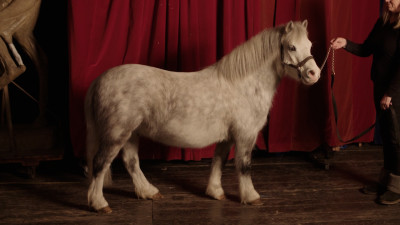
Inside the Academy
< 4 years ago
Life drawing with Romeo the pony
Two legs good, four legs better? Grab your pencils and sketch this tiny pony in two short poses from our 2019 event #LifeDrawingLive: the anatomy class.

Our Collection
> 4 years ago
7 life drawing shorts to do at home
In 2018, we hosted the world’s first-ever livestreamed life drawing class from the Royal Academy’s famous Life Room, #LifeDrawingLive. Grab a pencil and have a crack at each pose by life model Andrew Crayford.

Our Collection
> 4 years ago
How to read it: Annie Swynnerton’s The Letter
In 1922, the Royal Academy elected its first female member in over 150 years, Annie Swynnerton – here’s how to read her enigmatic painting of a young woman.

Opinion
> 4 years ago
“We can’t open our doors just yet – but today we are inviting you inside.”
Jump into the Last Supper, put a masterpiece from our Collection in your own living room or take a virtual tour of our beautiful building on Google Arts & Culture.

Our Collection
> 4 years ago
How to read it: Meredith Frampton’s Still Life
This meticulous and mysterious work by Meredith Frampton is full of contrasting symbolism. Our Collections team guide you through it in this three-minute read.

Our Collection
5 years ago
Artists Cathie Pilkington and Alison Wilding on ‘The Ancestors’
Fiona Maddocks meets the former teacher and pupil duo about their co-curated project on their Academy forebears.

Artists
6 years ago
Family how-to: carve a Halloween pumpkin inspired by the RA Collection
Have a go at using a stencil to carve a pumpkin this Halloween. These stencils are all inspired by artworks from the RA Collection. Download it and get crafting!

RA Exhibitions
6 years ago
My art agenda: Sarah Pickstone
Sarah Pickstone, alumna of the RA Schools, discusses the inspiration behind her new works in Burlington House, her co-operative studio and the democratic nature of drawing.

Artists
> 6 years ago
Family how-to: make a stop-frame animation
Become a film director for the day and create your very own cartoon animation inspired by artworks from the RA Collection.
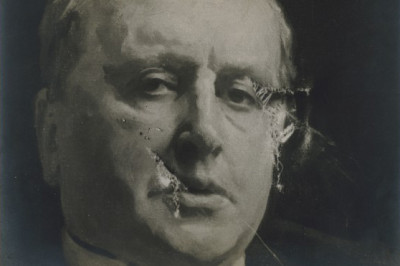
Our Collection
> 6 years ago
‘Deeds not words’: Suffragettes and the Summer Exhibition
The Great Spectacle charts 250 years of Summer Exhibitions – including 1914, when Suffragette Mary Wood attacked a John Singer Sargent portrait with a meat cleaver. We delve into the Royal Academy’s archive to find out how the Academy, and the public, reacted.

Our Collection
> 6 years ago
Quiz: which great British artwork are you?
To celebrate our 250th birthday, we’re finally putting the treasures of our Collection on free display all across the RA. Each artwork has its own unique character, so which one matches yours?

Inside the Academy
> 6 years ago
Video: behind the scenes at the new RA
Artistic director Tim Marlow gives a behind-the-scenes tour of the new Royal Academy of Arts.
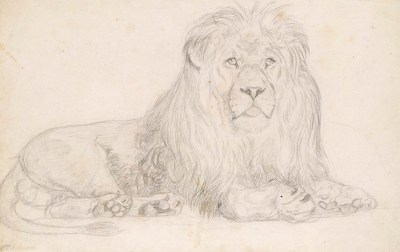
Artists
> 6 years ago
Family how-to: colour the RA Collection
Have a go at colouring different artworks from the RA Collection! Download a colouring sheet and crack out your pencils and pens.

Our Collection
< 7 years ago
How to read it: Henry Raeburn’s Boy and Rabbit
Take a closer look at Henry Raeburn’s Boy and Rabbit, an intimate family portrait from the RA Collection.

Our Collection
7 years ago
How to read it: Edward Burne-Jones’s The Summer Snow
Edward Burne-Jones and his fellow Pre-Raphaelites are famed for their paintings, but their illustrations, which were an important part of their early careers, are less well-known. Here’s a closer look at one of Burne-Jones’s wood engravings.

Our Collection
7 years ago
How to read it: Bill Woodrow RA’s Fingerswarm
Bill Woodrow RA’s Fingerswarm is part of a new display of sculpture curated by Richard Deacon RA. Woodrow held a swarm of bees on his bare hand at a beekeeping course, sparking the idea for this surreal sculpture.
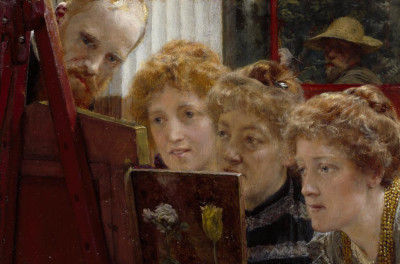
Our Collection
> 7 years ago
How to read it: Lawrence Alma-Tadema RA’s A Family Group
This painting-within-a-painting by Lawrence Alma-Tadema depicts his artist wife and her siblings examining an earlier work by the couple, painted to symbolise their marriage.

Artists
> 7 years ago
Richard Deacon: “Don’t depend on other people’s affirmation”
Turner Prize-winning artist Richard Deacon RA talks obsessive collecting, ambiguous titles and finding the interest in everything.

Our Collection
> 7 years ago
How to read it: Charles Tunnicliffe’s Chinese Geese
Pattern and design are as important as accuracy in this wood engraving by Charles Tunnicliffe RA. Come and take a closer look…

Our Collection
> 7 years ago
How to read it: Henry Tuke’s A Bathing Group
The year 2017 was the 50th anniversary of the partial decriminalisation of male homosexuality, marked at Tate Britain with an exhibition of ‘Queer British Art’, featuring Henry Tuke’s A Bathing Group from our collection. Take a closer look…

Our Collection
> 7 years ago
How to read it: Michelangelo’s Taddei Tondo
The Virgin and Child with the Infant St John, known as the Taddei Tondo, is the only marble sculpture by Michelangelo Buonarroti in a UK collection.
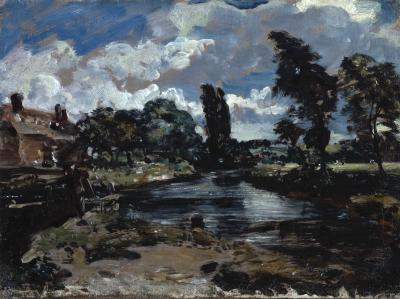
Our Collection
< 8 years ago
How to read it: Constable’s Flatford Mill study
Painted quickly to develop ideas before the final work, this is one of 16 oil sketches by John Constable RA in our collection. Here’s an introduction to Flatford Mill from a Lock on the Stour.

Our Collection
< 8 years ago
The 12 days of gifmas
Merry Christmas, art-lovers! This morning we bring you some light entertainment from the RA Collection – which, it turns out, is chock-a-block with pipers piping, french hens and maids a-milking. We’ve made just a few festive alterations…

RA Recommends
8 years ago
Five of the best London archives
The RA archive is a treasure trove of stories, memories and recordings about art and artists from the past 250 years. In honour of Explore Your Archive week, we introduce some of its highlights and four more London archives to explore, holding everything from American performance art footage to rare Japanese prints.
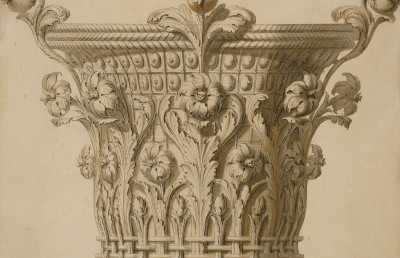
Our Collection
8 years ago
How to read it: “the origin of the Corinthian order”
Sir William Chambers’s beautiful 18th-century drawing tells an ancient story about the beginnings of architecture.

Our Collection
> 8 years ago
How to read it: John Gibson’s Cupid and Psyche
Take a closer look at how one of Britain’s most celebrated 19th-century sculptors tackled an ancient Roman tale in marble.

Artists
> 9 years ago
Six ways the Napoleonic Wars changed British art
The conflict blocked artists from travelling – but also led to a boom in the art market and the arrival of works by Titian and van Eyck. As a wave of commemorations marks Waterloo’s 200th anniversary, our Curator of Works on Paper explains.

Inside the Academy
> 9 years ago
A day in the life: Morgan Feely, Collections Manager for Works on Paper
As he prepares to open a new retrospective of the work of Eileen Cooper RA, we chat to Morgan Feely about his daily life at the RA.

Our Collection
< 10 years ago
On the Reynolds trail in the RA archive
On the eve of a major exhibition in London dedicated to Sir Joshua Reynolds, we delve into the RA’s archive to learn more about the Academy’s founding president.

Our Collection
10 years ago
Explore the John Madejski Fine Rooms rehang
Learn more about some of the highlights of our Collection that have recently gone on show in the John Madejski Fine Rooms.

Inside the Academy
> 10 years ago
Dazzle ships and the Royal Academy
How the RA played a role in the development of a dazzling new form of camouflage.
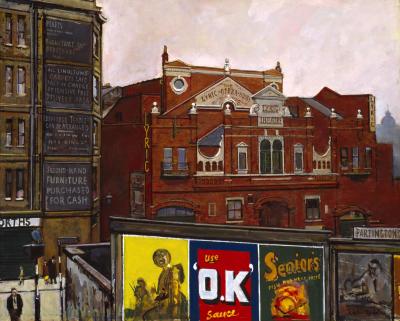
Our Collection
> 10 years ago
Artist of the Month: July 2014
As a flamboyantly self-styled “working-class cockney”, Ruskin Spear RA found subjects for painting in the pubs, snooker halls and streets of Hammersmith, Fulham, Shepherd’s Bush and Chiswick.
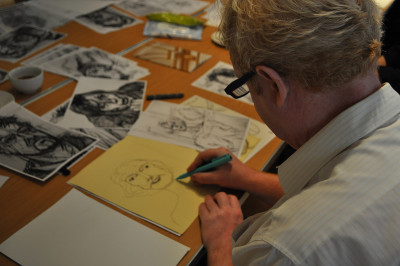
Inside the Academy
> 10 years ago
Community Art Club: forging a connection
For many homeless and marginalised people, art-making can seem a closed-off world. Our learning team tell us how the RA is trying to change that.

Our Collection
> 10 years ago
From aquatints to woodcuts: a visual glossary of original prints
We take a look at the main printmaking techniques and some of the terminology you’ll encounter when looking at original prints.

Inside the Academy
< 11 years ago
With William Kent at Burlington House
As the V&A celebrates the highly influential artist and designer, we reveal how William Kent’s career came to life with his work for Burlington House – now the home of the Royal Academy.

Inside the Academy
< 11 years ago
How do Academicians get elected?
Recent years have seen a host of new innovations here at the RA, but the election process for new Academicians has hardly changed in almost 250 years. Here is how it all works.
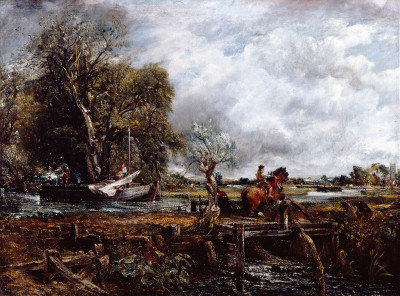
RA Exhibitions
12 years ago
Constable, Gainsborough, Turner and the Making of Landscape
Tracing the emergence of landscape painting as a distinct genre in its own right.